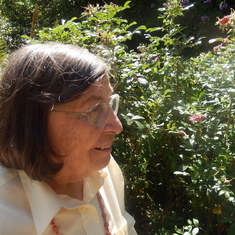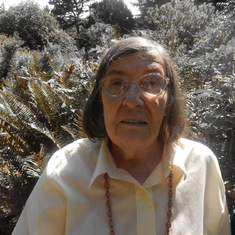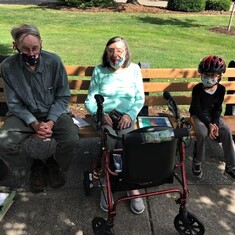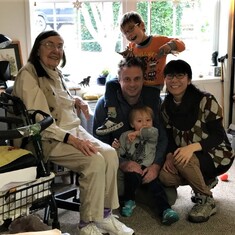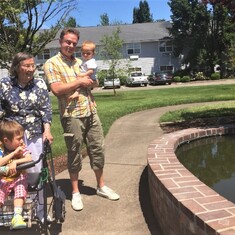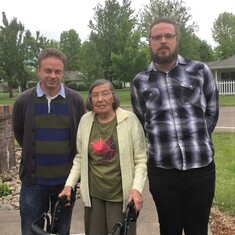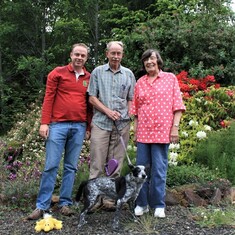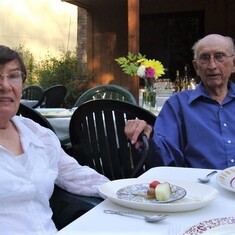Interview with Janice Gerdemann
The Yachats Gazette was pleased to be able to interview Janice Gerdemann shortly after her 90th birthday.
TYG: Where are you from, originally?
Janice: East St. Louis, Illinois. East St. Louis is the other side of the Mississippi River.
TYG: How did you meet Jim Gerdemann?
Janice: Well, after I graduated from college, I worked for Procter & Gamble market research for three years, and then I decided to come back to the University of Illinois and then work on a Master’s degree, provided I could get an assistantship to provide my living expenses. So I came back at homecoming time, though I wasn’t a big football fan. I talked to a couple of professors I’d known, in fact the same one who’d gotten me the job at Procter & Gamble and told him I’d like to come back if I could get an assistantship. And he said, “Well, I’d take you on!” [laughs] So I said “Fine!” I was even a little confused at that point—I was a liberal arts, not a business major, and he was in the College of Commerce, so I quickly got transferred to things that he had in mind. But that was fine—we had a good time. He was looking for somebody to help him make surveys for the Department of Commerce. The university liked to be of service—if they’re of service to the state, they’re more likely to get their funding when the budget is passed. [chuckles]
I’ll tell you one incident about working for Professor Converse:
He wanted us to go down to—not Cairo in Egypt, but Cairo [kay-ro] in Illinois—it’s a city on the banks of the Ohio River. We were going to do a survey for the Chamber of Commerce down in Cairo. They have an institute of aviation at the University of Illinois, and they’ll supply a pilot and three more seats on an airplane to take you wherever you want to go in service of the University. So the pilot flew Professor Converse, and one male graduate student, and me, down to Cairo. Professor Converse went around and talked to the Chamber of Commerce, and the other guy and I made our little survey around town. We had a sample of people to talk to—it was supposed to be done semi-scientifically but we just got enough diversity of people in town and we would ask them what they liked about the business there, and how far they’d go to shop elsewhere—that’s what they wanted to know. We got that done in a couple of hours or so and came back and met Professor Converse and the pilot. It was pretty muddy on the banks of the Ohio River down there, and it had be flooded recently. The four of us got on the plane and we couldn’t take off—it was too muddy! So somebody came out from the office, and he suggested that he and the graduate student could take hold of the edge of one of the plane wings, and they would run along and the pilot would start the engine and see if he could lift out of the mud! So they did that, and it came out of the mud. The graduate student jumped back into the plane, and we had enough space to take off!
So the first year I was there, starting to work on a Master’s degree, I met Jim. I’d rented a room in a house across from where he was living, and we both went to the Unitarian Church, and that’s where we met. He lived in the basement of the Unitarian Church, and had just come back from Berkeley, California—that’s where he got his Ph.D. degree in plant pathology.
TYG: What was life like for you as a young adult, after you met Jim Gerdemann?
Janice: Well, we hit it off quickly. He was not very fond of the plains of Illinois, though. The people at Berkeley had suggested this job to him, because it was next to Missouri, where he came from. Well, Illinois isn’t like Missouri at all! [laughs] Illinois is a flat plain down two thirds from Chicago—the glaciers flattened the land. But Missouri, where Jim grew up, had a lot of woods and creeks and rough land—not crop land, like the corn and soy beans in Illinois. But I think he did like his job—the people were nice, he found out after a while.
To make a long story short, after about six months he said, “Well, I have to go back to Oregon as soon as this term is over. I don’t have three months’ vacation like the people who are just teaching. I have a teaching job with research, and it’s considered a 12-month job with one month’s vacation. I’m going to go to Oregon. Would you like to go with me to Oregon? If you would, we’ll have to get married.” [laughs] Because that was the custom then—you had to get married before you went traveling together.
TYG: That’s a weird custom.
Janice: Yes, right! [laughs] So I said, “I’ll think about it for a little bit.” But not for long. I really wanted to go to Oregon with him—I really liked him from the beginning. Anyway, I said, “Well, we have to go meet each other’s parents first.” So we hurried up and did that, and we got married at my parents’ house in East St. Louis, then we went back [to the University of Illinois]. Then some advisor said that it would probably be better if we lived together for a couple of weeks before we went camping back to Oregon. We thought maybe that would be okay, and we’d rented an upstairs apartment in the home of another professor who was retired, so we had that. Then we took off camping and went to Oregon. Jim earned his whole way through college by working in the forests in Oregon. In those days we didn’t travel as readily across the country as we do now. [Janice and Jim stayed in Urbana, Illinois, for the rest of Jim’s career, and raised three sons there.]
TYG: Were you interested in botany before you met Jim?
Janice: Well, the most interest I had in botany was one day, my dad told me there was a city-wide contest in East St. Louis for children up to 12 to have a backyard garden. They’d have judges coming around and judging for first, second, and third prize, or something like that. The bottom third of the garden had been fenced off for a little playground, and he said “Well, you could plant a little garden around the playground, and I’ll fence it off for you if you like. So I said okay, and I’d buy some packages of seed from the hardware store. So they had a packet of nasturtium seed that was “Guaranteed to bloom!” [laughs] Nasturtiums are great bloomers here in Oregon, you know. [The story ends up being interrupted by somebody asking for directions.]
TYG: So how did you end up in Yachats?
Janice: Oh, we loved Yachats from the beginning.
TYG: How did you and Jim establish the [Gerdemann] Garden?
Janice: He was really going to retire. Sometimes he [would attend] a Western Regional Plant Pathology meeting, and by that time our son was going to Oregon State University. When the meeting was over, he picked up that son (Steve), and had a weekend before he came back to his job in Illinois, and he looked at possible places to retire. Brookings is the “banana belt” of Oregon, so that was the natural place for him to look first. But he was put off at Brookings by the grocery store, and other downtown buildings, not planting any exotic plants that they had the climate for and could have made use of for doing something interesting, and they only had privet bushes around there—privet can be grown anyplace in the US! [laughs] So he said that Brookings wasn’t a very imaginative place. So then he looked at Gold Beach, and I guess he met with some real estate agents and looked at some properties and different places. We had done a lot of camping, and knew a lot about Oregon, mostly southern Oregon. We were fond of the Siskiyou Mountains in southern Oregon, kind of adjacent to the mountains in California—Cascades-Siskiyou. But the plant, Kalmiopsis, that the wilderness down there is named for, was originally thought to be a rhododendron, but then they decided that it was a separate species, a little bit different from rhododendrons as such. It was found by a botanist named Mrs. [Lilla] Leach. She had a pharmacist husband, and they lived in Portland. They did a lot of hiking and botanizing, they called it, in the Cascades-Siskiyou National Forest. She also discovered something related to nitrogen-fixing plants. Kalmiopsis leachiana is the rhododendron relative, and there are even two forms of it now. Jim was already growing it, I think, or he did shortly after we came to Oregon. On our previous camping trips to Oregon we had visited nurseries that grew rhododendrons and taken some back to Illinois. It was funny—sometimes big nurseries, like Van Veen’s—a Dutch family that came over here. They would sometimes give us something to take back to Illinois on condition that we give them a report back on whether it survived, how hardy we would find it to be. Oregon is a huge nursery for the rest of the country: the nursery business in Oregon is the biggest crop they have. So it’s big business to them: they sell to the East out here. So [Jim] would get donations to take back and try. So... where were we in this conversation? I go astray...
Oh, so Jim looked at this piece of land that he liked in Oregon—the guy [selling it] was getting divorced. They needed to sell two-thirds of their property at the head of Forest Hill Street in order to split the money between them. He was going to stay on the land—in fact, he was in the business of buying and selling land working for somebody else. So Jim put a down-payment on this piece of land, because it was right next to the forest—that was more important than the view of the ocean. That was just on a business trip during a weekend, and he told me about it; when the [school] term was over we would go back out and look at it, and I could have a good look at it before we bought it for sure. So we camped on that piece of land and looked around.
We had some friends in Waldport, at Sandpiper—they came out after three days and said “You’ve been out here in the boonies by yourself long enough, you’d better come and sleep on a bed inside for a while. But for the first part of our stay we camped there and went down to the Adobe for Jim to shave and me to wash my face or whatever and we’d do breakfast down there, and cook dinner on our stove at the campsite, on that land which we ultimately bought. So I had a few reservations, but I gave my approval to the site anyway. Jim had an answer for all of them. There was sort of a rough dog out there—Jim was pretty sensitive to barking dogs at night, but he said, “Oh, I can make friends with that dog!” [laughs] You see, he was eager to do it! Somebody else was making illegal shingles from cedar trees; we suspected he hadn’t paid the Forest Service for going up there and helping himself to [the wood], but [Jim] said, “Well, that’s a very temporary thing.” [laughs] And he was right! So, we went back [to Illinois] and hunted for a house plan, and I made a cardboard model of it, and we came back and built it.
TYG: Cool! So, what are you doing these days?
Janice: Well, we spent 30 years collecting plants from our trips to South Africa and New Zealand that were related to Jim’s profession, really. So what am I doing now? Jim has died, and I live in assisted living, if you want to know. [...] I’d like to move back to Yachats, but there are difficulties in a town with not very many facilities if you don’t have a car. My friend Gerald, Gerald Stanley, collected bus schedules. He showed me how I could easily get [from Albany] over to Yachats on two buses. After I broke my leg they came over to see me—a number of people did. But I still have way more friends in Yachats than anyplace else. But I am going to a yoga class that is separate from the continuing care facility where I live now, and I walk there. And the people in their golf carts wave at me. Everybody knows me because I walk with my walker down the streets that are restricted to 25 mph. [...] But I always wonder if those could be used in Yachats—you should be able to cross 101. I come over to Newport sometimes, because I can come and go in one day, like for Milo [Graamans]’s play at the Visual Arts Center. I can do that in one day. Milo used to be my computer helper when he was in high school. He would come over once a week. We were friends, and I was always snagged on something on the computer and needed somebody to help me once a week, and he did. So I’m very fond of Milo and other people around here—many people. Although lately the turn-over seems pretty great. I go into the Green Salmon and I’m lucky if I see one or two people I know. [...] But thank goodness for friends and buddies!
TYG: Well, thank you so much for your time!
Janice: Thank you!

